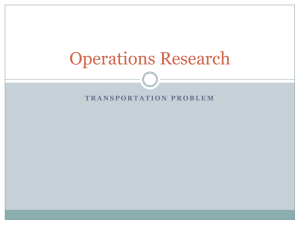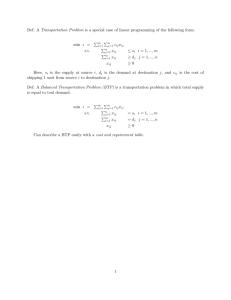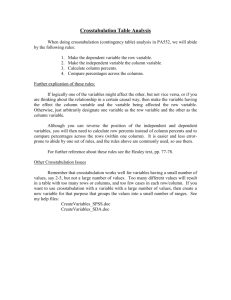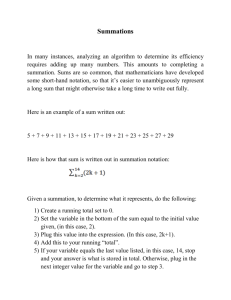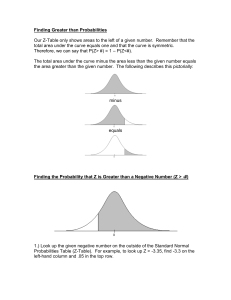Transportation, Assignment, and Transshipment Problems Consider
advertisement
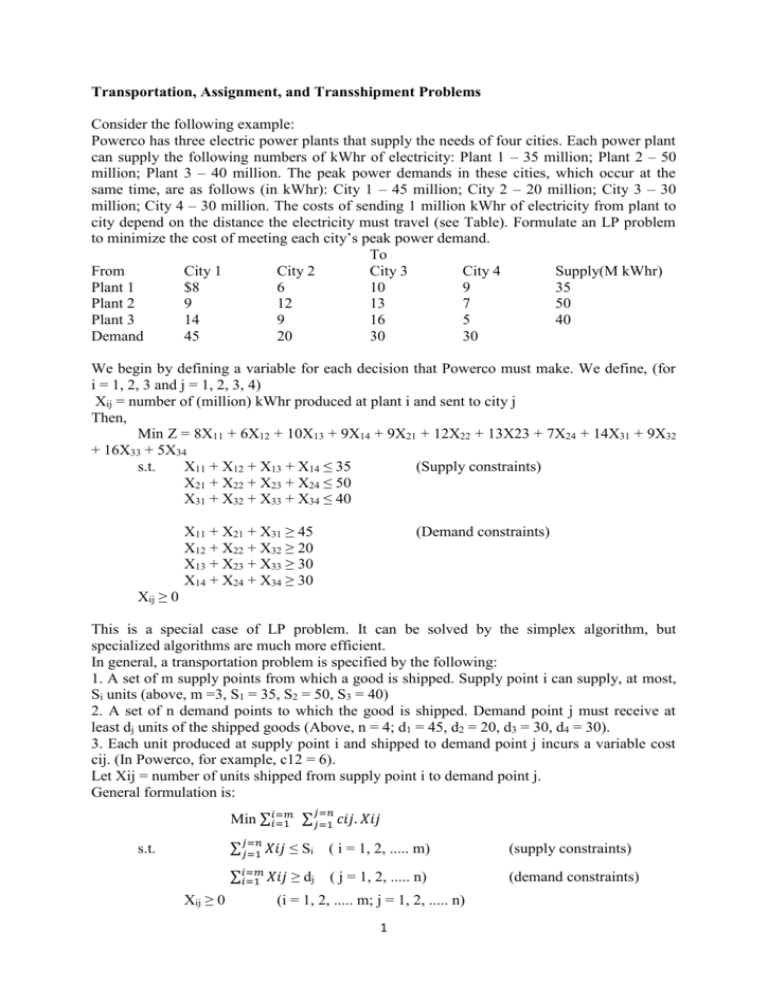
Transportation, Assignment, and Transshipment Problems
Consider the following example:
Powerco has three electric power plants that supply the needs of four cities. Each power plant
can supply the following numbers of kWhr of electricity: Plant 1 – 35 million; Plant 2 – 50
million; Plant 3 – 40 million. The peak power demands in these cities, which occur at the
same time, are as follows (in kWhr): City 1 – 45 million; City 2 – 20 million; City 3 – 30
million; City 4 – 30 million. The costs of sending 1 million kWhr of electricity from plant to
city depend on the distance the electricity must travel (see Table). Formulate an LP problem
to minimize the cost of meeting each city’s peak power demand.
To
From
City 1
City 2
City 3
City 4
Supply(M kWhr)
Plant 1
$8
6
10
9
35
Plant 2
9
12
13
7
50
Plant 3
14
9
16
5
40
Demand
45
20
30
30
We begin by defining a variable for each decision that Powerco must make. We define, (for
i = 1, 2, 3 and j = 1, 2, 3, 4)
Xij = number of (million) kWhr produced at plant i and sent to city j
Then,
Min Z = 8X11 + 6X12 + 10X13 + 9X14 + 9X21 + 12X22 + 13X23 + 7X24 + 14X31 + 9X32
+ 16X33 + 5X34
s.t.
X11 + X12 + X13 + X14 ≤ 35
(Supply constraints)
X21 + X22 + X23 + X24 ≤ 50
X31 + X32 + X33 + X34 ≤ 40
X11 + X21 + X31 ≥ 45
X12 + X22 + X32 ≥ 20
X13 + X23 + X33 ≥ 30
X14 + X24 + X34 ≥ 30
(Demand constraints)
Xij ≥ 0
This is a special case of LP problem. It can be solved by the simplex algorithm, but
specialized algorithms are much more efficient.
In general, a transportation problem is specified by the following:
1. A set of m supply points from which a good is shipped. Supply point i can supply, at most,
Si units (above, m =3, S1 = 35, S2 = 50, S3 = 40)
2. A set of n demand points to which the good is shipped. Demand point j must receive at
least dj units of the shipped goods (Above, n = 4; d1 = 45, d2 = 20, d3 = 30, d4 = 30).
3. Each unit produced at supply point i and shipped to demand point j incurs a variable cost
cij. (In Powerco, for example, c12 = 6).
Let Xij = number of units shipped from supply point i to demand point j.
General formulation is:
𝑗=𝑛
Min ∑𝑖=𝑚
𝑖=1 ∑𝑗=1 𝑐𝑖𝑗. 𝑋𝑖𝑗
s.t.
Xij ≥ 0
∑𝑗=𝑛
𝑗=1 𝑋𝑖𝑗 ≤ Si
( i = 1, 2, ..... m)
(supply constraints)
∑𝑖=𝑚
𝑖=1 𝑋𝑖𝑗 ≥ dj
( j = 1, 2, ..... n)
(demand constraints)
(i = 1, 2, ..... m; j = 1, 2, ..... n)
1
If constraints are as above and it is a max problem, it is still a transportation problem.
If,
∑ Si = ∑ dj
supply equal demand, it is said to be balanced transportation problem. Powerco is a balanced
transportation problem.
For balanced transportation problem,
Min ∑∑ cijXij
∑ Xij = Si ( i = 1, 2, ..... m)
∑ Xij = dj ( j = 1, 2, ..... n)
s.t.
Xij ≥ 0
(supply constraints)
(demand constraints)
(i = 1, 2, ..... m; j = 1, 2, ..... n)
Solution of balanced transportation problem is simpler, therefore, it is desirable to formulate a
transportation problem as a balanced transportation problem.
Transportation problem is specified by the supply, the demand, and the shipping costs, so the
relevant data can be summarized in a transportation tableau. The cell in row i and column j
corresponds to the variable Xij. If Xij is a basic variable, its value is normally placed in the
lower hand corner of the ij th cell of the tableau. The costs are normally shown in the upper
right corner. The following tableau is for the Powerco problem. (The optimal solution values
are also given).
City 1
8
Plant 1
Plant 2
Plant 3
Demand
City 2
City 3
City 4
10
9
13
7
6
10
9
25
12
45
5
14
9
16
10
45
5
30
20
30
2
30
Supply
35
50
40
Balancing a Transportation Problem if Total Supply exceeds Total Demand
If this is the case, we can balance a transportation problem by creating a dummy demand
point that has a demand equal to the amount of excess supply. Because shipments to the
dummy demand point are not real shipments, they are assigned a cost of zero. Shipments to
the dummy demand point indicate unused supply capacity.
Example 1. SunRay Transport Co ships grain from three silos to four mills. The supply in
tons and the demand together with the unit transportation cost on the different routes are given
in the Table below. The Company seeks to minimize shipping costs.
1
Mill
3
2
10
2
4
20
Supply
11
1
15
12
Silo
7
9
20
25
2
4
14
16
18
20
3
Demand
5
15
15
15
Formulate a balanced transportation problem that can be used to minimize the shipping costs.
Formulation:
1
Mill
3
2
10
2
4
20
Dummy
11
0
1
15
12
Silo
7
9
20
0
25
2
4
14
16
18
0
20
3
Demand
Supply
5
15
15
15
10
Note: There are some examples where unused capacity may not be acceptable for some of the
supply points. For example, it may be required that all of the supply of Silo 1 be used for the
demand points, i.e. there should not be any allocation to Dummy from Silo 1. Then, we assign
a cost of M to the relevant cell (c1D) which forces assignment X1D to zero.
3
Total Supply is less than Total Demand
If this is the case, then the problem will not have a feasible solution as the demand cannot be
met. However, it is sometimes acceptable to allow the possibility of leaving some demand
unmet. In such situations, a penalty is often associated with unmet demand.
Example 2. Company X supplies its four outlets from its two plants.The shipping cost ($K)
per shipment from each plant to each outlet is given in Table below along with the amount of
supply available from each factory and the amount of demand at each outlet. There is a cost
penalty for each unmet shipment demand: It is $K4, $K3, $K8, and $K5 for outlets 1, 2, 3,
and 4 respectively.
Outlets
1
2
3
4
Supply
Plants
1
2
Demand
3
7
6
4
2
4
3
2
3
3
2
5
2
2
Formulate a balanced transportation problem that can be used to minimize the shipping costs.
Formulation:
1
Plants
1
2
Dummy
Demand
Outlets
3
2
3
4
Supply
3
7
6
4
2
4
3
2
2
4
3
8
5
3
3
2
5
2
Note: In all types of transportation problems, there are special situations whereby shipments
from supply point i to demand point j is not possible. Then, the assigned cost is cij = M, which
forces Xij to 0, satisfying the above mentioned restriction.
4
Finding Basic Feasible Solution for Transportation Problems
North-west Corner Method
We begin in the upper left (north-west) corner of the tableau and set X11 as large as possible
(cannot be larger than s1 or d1). If X11 = s1, cross out the first row. Also, change d1 to (d1- s1).
If X11 = d1, cross out the first column and change s1 to (s1 – d1). Continue applying procedure
to the north-west cell that does not lie in the crossed out row or column until there is one cell
left.
Example:
1
2
4
Supply
3
5
2
1
1
3
0
2
1
4
1
0
x
2
1
1
Demand
2
3
2
x
3
x
x
3
x
Minimum Cost Method
North-west method does not consider costs, may lead to more iterations before optimal
solution is reached. This method uses costs. To begin the minimum cost method, find the
variable with the smallest shipping cost (say Xij). Then assign Xij its largest possible value,
min{si,dj}. Cross out row i or column j and reduce the supply or demand of the non-crossed
out row or column by the value of Xij. Then choose from the cells that do not lie in a crossed
out row or column the cell with the minimum cost and repeat procedure. Continue until there
is one cell that can be chosen.
2
3
5
6
5
2
2
1
3
3
8
12
10
5
x
4
8
x
5
x
10
2
15
10
5
8
5
5
6
4
6
4
6
x
Vogel’s Method
Minimum cost method can sometimes be fooled to choose a costly bfs. Vogel’s method
usually avoids this.
Begin by computing for each row (and column) a “penalty” equal to the difference between
the two smallest costs in the row (column). Next, find the row or column with the largest
penalty. Choose as the first basic variable the variable in this row or column that has the
smallest shipping cost. Make this variable as large as possible, cross out row or column, and
change the supply or demand associated with the basic variable. Now recomputed new
penalties (using only cells that do not lie in the crossed out row or column), and repeat the
procedure until only one uncrossed cell remains. Set this variable equal to the remaining
supply or demand.
6
0
7
5
15
Row Penalty
8
5
80
10
78
15
15
5
0
7–6=1
8-6=2
78-15=63
63
15
Column penalty 15 – 6 = 9
5
5
80–7= 73 78-8= 70
x
x
( as can be seen, avoids the costly shipments associated with X22 and X23).
Of the three methods, North-west corner method requires the least effort, and Vogel’s method
requires the most effort. Vogel’s method is generally preferred as the bfs found lead to a
solution with much fewer iterations. (note also that there are other methods of finding bfs).
How to Pivot in a Transportation Problem
Definition of a Loop:
Any ordered sequence of at least four different cells is called a loop if,
(1) any two consecutive cells lie in either the same row or column,
(2) No three consecutive cells lie in the same row or column,
(3) the last cell in the sequence has a row or column in common with the first cell sequence.
Loop
Loop
No
6
No
Pivoting:
Step 1. Determine the variable that should enter the basis
Step 2. Find the loop (there is only one) involving the entering variable and some of the basic
variables.
Step 3. Counting only cells in the loop, label those found in step 2 that are even numbers (0,
2, 4, etc. with zero being the cell for the entering variable). The others are odd numbered cells
( we start even, odd, even, and so on).
Step 4. Find the odd cell whose variable assumes the smallest value. Call this θ. The variable
corresponding to this odd cell will leave the basis. To perform the pivot, decrease the value of
each odd cell by θ and increase the value of each even cell by θ. The values not in the loop
remain unchanged. (Only cells at the corners of the loop are in the loop). The pivot is now
complete; we have a new bfs.
Pricing out Non-basic Variables
We now show how to compute row 0, i.e. objective function coefficients.
It was shown that
cij = cBVB-1aij – cij
(*)
If we define cBV.B-1 = [u1 u2 …um v1 v2 …vn]
where u1, u2, …um are the elements of cBV.B-1 corresponding to “m” supply constraints, and
v1, v2, ….vn are the elements of cBV.B-1 corresponding to the “n” demand constraints. The fact
that we have (m + n – 1) basic variables and (m + n) constraints (one of the constraints is
redundant because of the equality constraints and can be deleted without changing the feasible
region). We can therefore make any one of the values, say u1 = 0, without affecting other
values.
Then, we can determine the values of [u1 u2 …um v1 v2 … vn] from equation (*) as it
reduces to
ui + vj = cij
(**)
for all basic variables.
(using the BV’s in the bfs, we obtain values after solving the resultant equations and
substituting u1 = 0. If we wish to, we may choose to make another element zero instead of u1)
How to Determine Entering Variable
Having obtained the values for ui and vj, we can determine the coefficients of the non-basic
variables in row 0 from,
cij = ui + vj – cij
If we are working on a minimization problem, if all cij values are negative, then we have an
optimal solution.
i.e. ui + vj – cij ≤ 0 optimal.
If, however, ui + vj – cij > 0, then objective function Z can be increased by entering Xij into
basis.
The variable with the most positive cij enters into basis.
7
Summary
1. If the problem is unbalanced, balance it.
2. Use one of the methods to find a bfs.
3. Use ui + vj = cij (u1 = 0) for all basic variables to find (u1 u2 …um v1 v2 …vn) for the current
bfs.
4. If ui + vj – cij ≤ 0 for all non-basic variables, then current bfs is optimal. If this is not the
case, then enter the variable with the most positive (ui + vj – cij) into the basis using the
pivoting procedure.
5. Using the new bfs, return to step 3 and 4.
For maximization, if (ui + vj – cij ≥ 0) for all non-basic variables, then we have an optimal
solution. Otherwise, choose the variable with the most negative (ui + vj –cij) to enter.
Assignment Problems (see Winston)
Although the transportation simplex appears to be very efficient, there is a certain class of
transportation problems, called assignment problems, for which the transportation simplex is
often very inefficient.
Example: Machineco has four machines and four jobs to be completed. Each machine must be
assigned to complete one job. The time required to set up each machine for completing each
job is shown in Table below. Machineco wants to minimize the total setup time needed to
complete the four jobs. Use linear programming to solve this problem.
Solution: Machineco must determine which machine should be assigned to each job. We
define (for i, j = 1, 2, 3, 4)
xij = 1 if machine i is assigned to meet the demands of job j
xij = 0 if machine i is not assigned to meet the demands of job j
Then Machineco’s problem may be formulated as
Min Z = 14x11 + 5x12 + 8x13 + 7x14 + 2x21 + 12x22 + 6x23 + 5x24 + 7x31 + 8x32 + 3x33 + 9x34 +
2x41 + 4x42 + 6x43 + 10x44
s.t.
s.t.
s.t.
s.t.
x11 + x12 + x13 + x14 = 1
(Machine constraints)
x21 + x22 + x23 + x24 = 1 (Machine constraints)
x31 + x32 + x33 + x34 = 1 (Machine constraints)
x41 + x42 + x43 + x44 = 1 (Machine constraints)
s.t.
s.t.
s.t.
s.t.
x11 + x21 + x31 + x41 = 1
(Job constraints)
x12 + x22 + x32 + x42 = 1 (Machine constraints)
x13 + x23 + x33 + x43 = 1 (Machine constraints)
x14 + x24 + x34 + x44 = 1 (Machine constraints)
s.t.
xij = 0 or xij = 1 (Machine constraints)
The first four constraints above ensure that each machine is assigned to a job, and the last four
ensure that each job is completed. If xij = 1, then the objective function will pick up the time
required to set up machine i for job j; if xij = 0, then the objective function will not pick up the
time required.
8
Setup Times for Machineco
Time (Hours)
Machine
Job 1 Job 2 Job 3
1
14
5
8
2
2
12
6
3
7
8
3
4
2
4
6
Job 4
7
5
9
10
We see that Machineco faces a balanced transportation problem in which each supply point
has a supply of 1 and each demand point has a demand of 1. In general, an assignment
problem is a balanced transportation problem in which all supplies and demands are equal to
1. Thus, an assignment problem is characterized by knowledge of the cost of assigning each
supply point to each demand point. The assignment problem’s matrix of costs is its cost
matrix.
Assignment problems may be solved by the transportation simplex. However, it may be an
inefficient way of solving assignment problems due to high degree of degeneracy in
assignment problems. For this reason and the fact that the algorithm is even simpler than the
transportation simplex, the Hungarian method is usually used to solve assignment (min)
problems.
Hungarian Method
Step 1. Find the minimum element in each row of the mxm cost matrix. Construct a new
matrix by subtracting from each cost the minimum cost in its row. For this new matrix, find
the minimum cost in each column. Construct a new matrix (called reduced cost matrix) by
subtracting from each cost the minimum cost in its column.
Step 2. Draw the minimum number of lines (horizontal or vertical or both) that are needed to
cover all zeros in the reduced matrix. If m lines are required, then an optimal solution is
available among the covered zeros in the matrix. If fewer than m lines are needed, then
proceed to step 3.
Step 3. Find the smallest non-zero element (call its value “k”) in the reduced cost matrix that
is uncovered by the lines drawn in step 2. Now subtract “k” from each uncovered element of
the reduced matrix and add “k” to each element that is covered by two lines. Return to step 2.
Note: For maximization problem, multiply profits by (-1) and solve as a minimization
problem. Also, if number of rows and columns are unequal, then the problem is unbalanced. It
should be balanced by adding dummy supply or dummy demand.
Solution to Machineco Example
Row Min
14
5
8
7
5
2
12
6
5
2
7
8
3
9
3
2
4
6
10
2
9
Column Min
9
0
3
2
0
10
4
3
4
5
0
6
0
2
4
8
0
0
0
2
9
0
3
0
0
10
4
1
4
5
0
4
0
2
4
6
After row minimums are
subtracted
After column minimums are
subtracted.
Fewer than m = 4 lines required
to cover all zeros. Proceed to
Step 3.
Smallest uncovered element is 1. We subtract 1 from each uncovered element and add 1 to
each twice covered element, i.e. x11 and x31.
10
0
3
0
0
9
3
0
5
5
0
4
0
1
3
5
Four lines are now required to
cover all zeros. Thus, an optimal
solution is available.
To find an optimal assignment, observe that only covered zero in column 3 is x33, so we must
have x33 = 1. Also, in column 2, only covered zero is x12, therefore x12 = 1. Now, row 1 and
column 3 cannot be used again.
From the remaining rows and columns, x24 is the only covered zero in column 4, so x24 = 1.
Finally, we choose x41 = 1.
Hence, optimal assignment is x12 = 1, x24 = 1, x33 = 1, and x41 = 1.
The cost, then is (5 + 5 + 3 + 2) = 15.
10
Transshipment Problems
In transportation problems shipments go directly from supply to a demand point. In many
situations, shipments are allowed between supply points or between demand points.
Sometimes, there may also be points (transshipment points) through which goods can be
transshipped on their journey from a supply point to a demand point. Shipping problems with
any or all these characteristics are transshipment problems.
We define:
Supply point – can only send good but cannot receive
Demand point – can receive goods but cannot send
Transshipment point – can receive from other points and can send goods to other points.
Example:
Widgetsco manufactures widgets at two factories, one in Memphis and one in Denver. The
Memphis factory can produce as many as 150 widgets per day, and the Denver factory can
produce as many as 200 widgets per day. Widgets are shipped by air to customers in Los
Angeles and Boston. The customers in each city require 130 widgets per day. Because of the
deregulation of airfares, Widgetco believes that it may be cheaper to first fly some widgets to
New York or Chicago and then fly them to their final destinations. The costs of flying a
widget is shown below. Widgetco wants to minimize the total cost of shipping the required
widgets to its customers.
To
From
Memphis
Denver
New York
Chicago
LA
Boston
Memphis
0
-
8
13
25
28
Denver
-
0
15
12
26
25
New York
-
-
0
6
16
17
Chicago
-
-
6
0
14
16
LA
-
-
-
-
0
-
Boston
-
-
-
-
-
0
Memphis, Denver: Supply points
New York, Chicago: Transshipment points
LA, Boston: Demand points
To solve the transshipment problem we create a balanced transportation problem and solve it.
11
Step 1. If necessary, add a dummy demand point (with a supply of 0 and a demand equal to
the problem’s excess supply) to balance the problem. Shipments to the dummy and from a
point to itself will have a zero shipping cost.
Step 2. Construct a transportation tableau. A row will be needed for each supply point and
transshipment point, and a column will be needed for each demand point and transshipment
point. Each supply point will have a supply equal to its original supply, and each demand its
original demand.
Let s = total available supply.
Then, each transshipment point will have a supply equal to
points original supply + s
and, a demand equal to
points original demand + s
Solution of problem in class.
12
